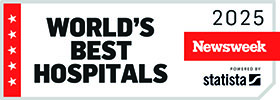Leslie

Survivor finds his stroke again
Mr. Leslie Colhoun was running his usual morning errands. He reached for his jacket hanging on the wall, but on this particular March morning, he couldn't move his left arm high enough to reach it. He knew immediately that something wasn't right.
Within minutes of alerting his wife, she called 911 and the North York resident was rushed to hospital. After a few days in acute care and multiple tests, doctors confirmed what Mr. Colhoun had already suspected - he had suffered a stroke.
The stroke left the avid golfer and grandfather of two weakened and with limited mobility. He was unable to walk on his own, nor continue with his every day activities. After his stay in acute care, Mr. Colhoun came to St. John's Rehab's stroke and neurological rehabilitation program.
A past president of the Ontario Heart Foundation and a major player in setting up the Heart and Stroke Foundation, Mr. Colhoun was familiar with the care offered at St. John's Rehab. He knew he had a challenging road ahead of him. Nevertheless, he wanted to reclaim his independence.
Our stroke and neurological rehabilitation program is designed for patients recovering from stroke, Multiple Sclerosis and other neuro-degenerative diseases. We also provide treatments for patients suffering from neurological deficits related to recent neurosurgery and neuro-oncology.
Working with an interdisciplinary team, patients like Mr. Colhoun receive extensive care that is tailored to each person's unique needs. Individualized treatment programs focus on addressing people's complex health, social and emotional issues.
The stroke program's highly skilled and dedicated rehabilitation professionals provide inpatient and outpatient care, education and support so patients can achieve a high quality of life, independence and recover sooner.
In order to help Mr. Colhoun reach his goal, his clinical team customized a rehabilitation program that focused on improving his mobility and dexterity in his hands and legs. After four weeks of routine exercise - such as walking 20 times per day around the hospital unit - Mr. Colhoun was walking on his own again.
"My team of clinicians has kept me motivated," says Mr. Colhoun. "My treatment is suited to my needs and has helped me regain strength and hope."
St. John's Rehab works with acute care hospitals to ensure patients get the best neurological care, when and where they need it. We are also advancing research, teaching and educating future health care professionals. St. John's Rehab has identified stroke as one of the six rehab research studies that we will invest in within the next five years. For patients like Mr. Colhoun, this could make the difference between spending more days recovering and getting home sooner to be independent again.
Following his inpatient rehabilitation, Mr. Colhoun has returned as an outpatient. He continues to work with a physiotherapist on exercises to further improve his balance and mobility. He is now practicing on an indoor golf putting set at the hospital's outpatient gym in the hope that he will soon get out on the golf course to finesse his game.
"I won't be better than my wife, but it would be good to play again," he says chuckling.
The Heart and Stroke Foundation reports that more than 50,000 strokes occur in Canada each year, averaging about one stroke every 10 minutes. After the age of 55, the risk of stroke doubles every 10 years. Knowing the signs of stroke and responding immediately to stroke concerns can significantly improve both survival and recovery.
There are five signs of stroke that, if recognized and quickly responded to, can be treated:
- Weakness: Sudden loss of strength or sudden numbness in the face, arm or leg, even if temporary.
- Trouble speaking: Sudden difficulty speaking or understanding or sudden confusion, even if temporary.
- Vision problems: Sudden trouble with vision, even if temporary.
- Headache: Sudden severe and unusual headache.
- Dizziness: Sudden loss of balance, especially with any of the above signs.
To learn more, visit www.heartandstroke.on.ca.





